Ultimate Ropa Vieja
This post may contain affiliate links. See my disclosure policy.
The ultimate version of one of Cuba’s most famous dishes, this Ropa Vieja recipe is positively PACKED with flavor!! A myriad of flavorful ingredients and spices come together to make this dish truly unforgettable. Make a double batch while you’re at it and you’ll be glad you have the leftovers (plus it freezes well). A reader favorite, check out the hundreds of rave reviews below!
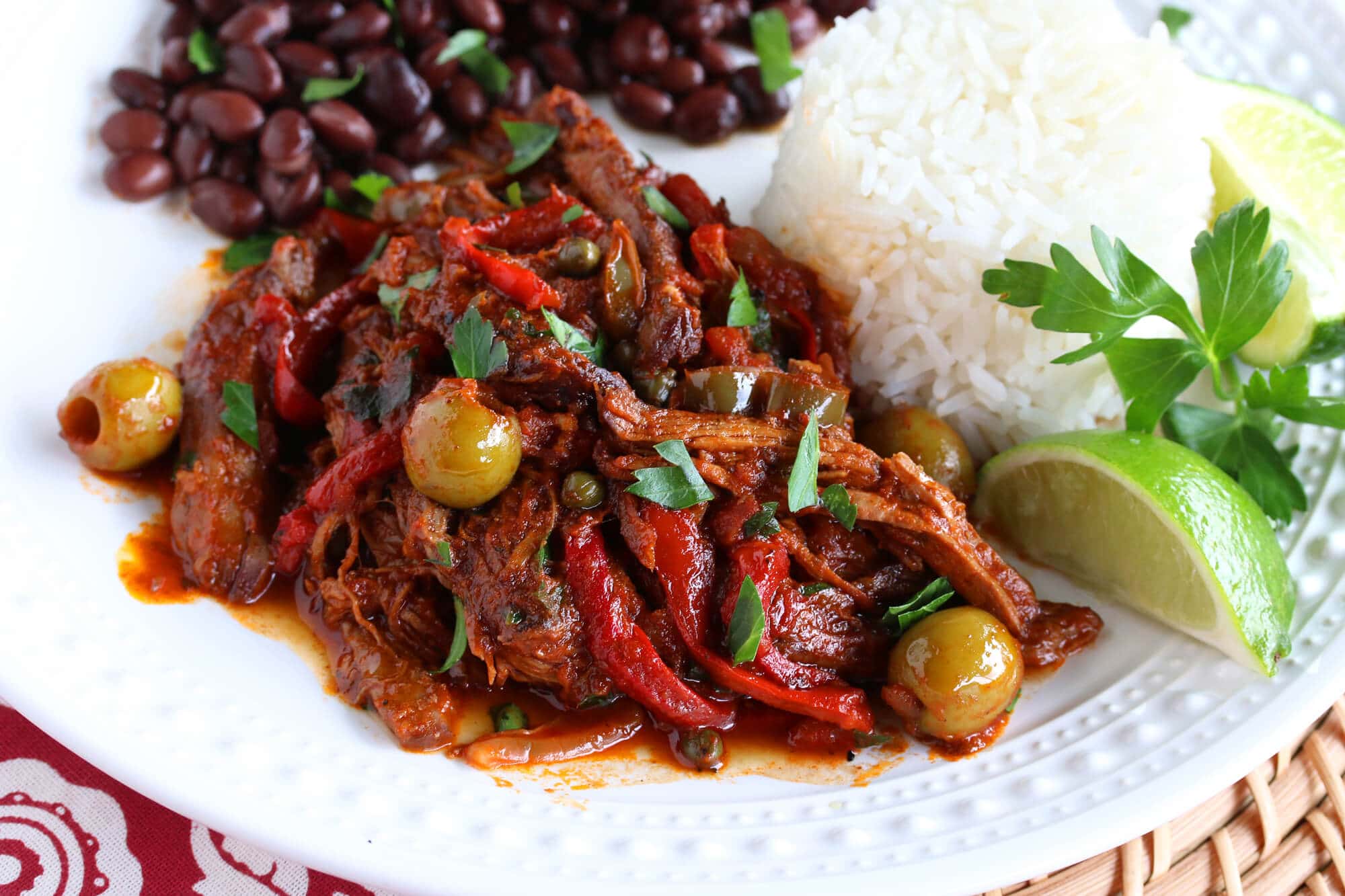
What is Ropa Vieja?
Shredded beef and vegetables that resemble a heap of colorful rags – that’s Ropa Vieja. From the Spanish term for “old clothes”, this is one of Cuba’s most popular and beloved dishes. So popular in fact that it’s one of the country’s designated national dishes.
This dish dates back to the Middle Ages of Spanish Sephardi, a loose adaptation of a dish that remains popular in southern and central Spain. Traditionally it was a way to stretch the leftovers of stews such as puchero or cocida, both of which are garbanzo-based dishes as is the original Spanish version of Ropa Vieja. This dish was later taken to Cuba where the Cubans made it their own.
Central in this dish are beef and tomatoes, both naturally umami-rich ingredients. Added to that are zesty bell peppers, caramelized onions, and to that we’re going to add some additional ingredients and spices that will make your taste buds sing with joy!
How to Make Ropa Vieja
Today we’re going to make some ultimate Ropa Vieja with a wonderfully rich depth of flavor! In the end you’ll have to make your own judgment call, but I’m pretty confident you’re going to love it (just check out the hundreds of rave reviews below)!
The traditional method for making ropa vieja involves simmering the beef in water, shredding it, and then adding it to the sauce. I’m going to show you a shortcut that not only saves time but results in a more flavorful dish. We’re going to sear the beef and then simmer it directly in the sauce, then shred it. This way all those flavorful juices from the beef go directly into the sauce. And it saves time. It’s a win-win. To mimic the extra step of making a separate stock, we’re also going to add whole carrots, celery and bay leaves and then discard them at the end, infusing the sauce with some umami qualities and natural sweetness from the vegetables.
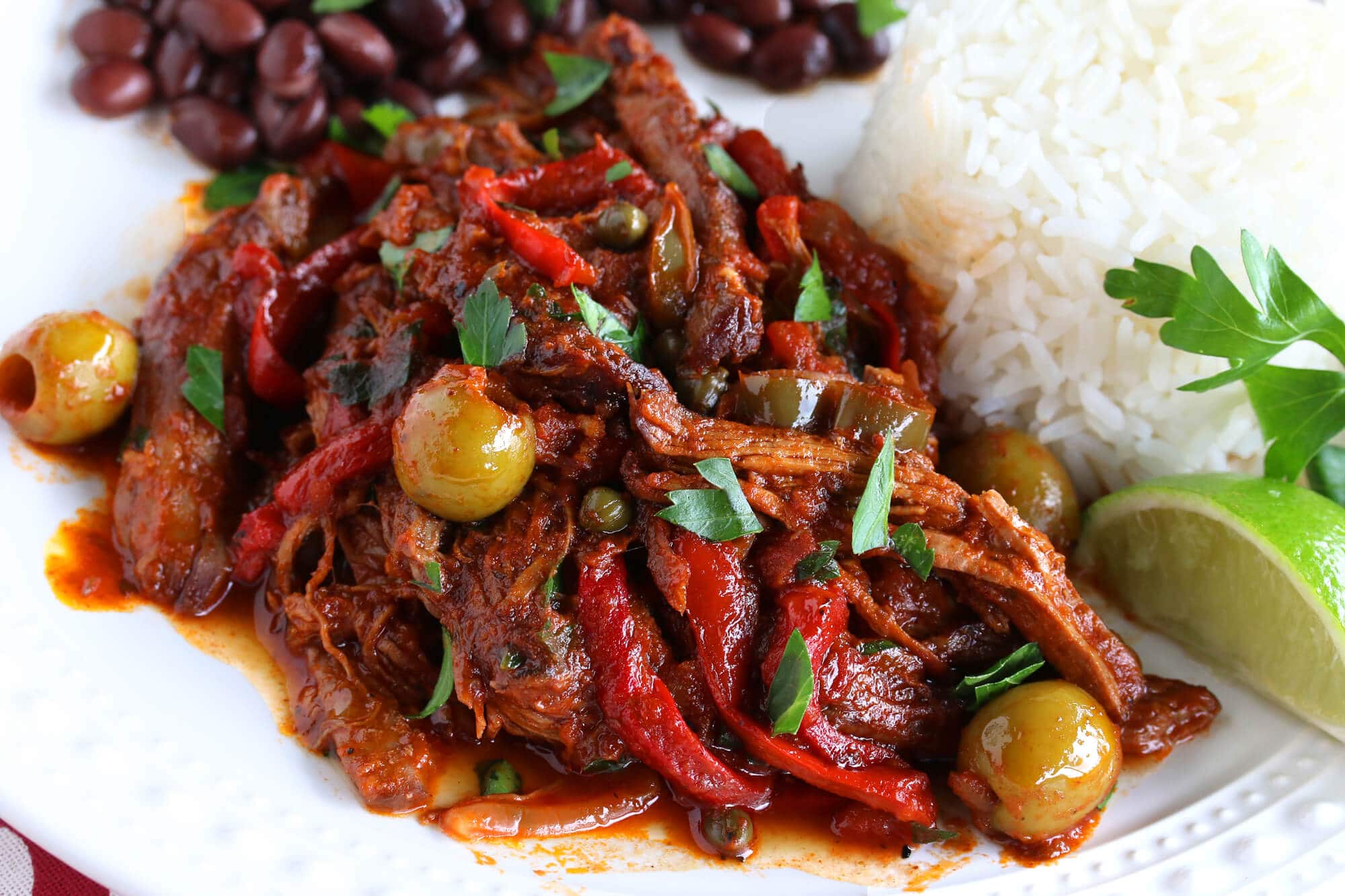
Ropa Vieja Ingredients
For our ultimate ropa vieja recipe we’re adding an array of other classic Cuban and Spanish ingredients such as olives, pimientos and capers. In addition to the red bell pepper that’s caramelized with the onions, we’re also going to add roasted red bell pepper in the end for added smokiness, sweetness and flavor.
You may be wondering, “what’s the difference between pimientos and red bell peppers? Aren’t they the same thing?” A pimiento, also called pimento or cherry pepper, is a variety of red chili pepper that is sweeter and more aromatic than red bell peppers (though some varieties of pimientos are hot). They add a nice element of natural sweetness and flavor to this dish.
What is the Best Cut of Beef to Use?
Traditionally Ropa Vieja is made with flank steak. Have a look around the internet at all the ropa vieja recipes and virtually all of them call for flank. That piqued my curiosity because here’s the thing: Flank steak is from the bottom hard-working muscle area of the cow (ie, very lean/very little fat) so it not only has less flavor than some other cuts of beef, it’s also notoriously tough.

Because of its low fat content, flank steak is best suited to very quick, high heat cooking, like grilling. It’s not the best choice for braising or slow cooking because without the fat content and connective tissue it dries out during the cooking process. For all of these reasons flank steak used to be one of the cheaper cuts of beef. But in recent years the price has sky-rocketed and in many places is double the cost of chuck. But flank still continues to be used in nearly all ropa vieja recipes out of tradition because of its shape – the grains of the cut yield long strands of shredded beef resembling the dish’s namesake, torn clothing.
Flank steak is unique in that respect with those long tough strands. But I wasn’t willing to sacrifice tenderness, flavor or cost for the sake of having long shreds of beef. So I went to three different butcher shops and chatted with their butchers. First I wanted to see their reaction when I told them I was looking for flank steak for a low and slow-cooked dish. All three raised their eyebrows and asked me why on earth I’d want flank steak for that. They all shook their heads and said that, hands down, the best choice for slow-cooked shredded beef was chuck. Better texture, better flavor and at nearly half the price of flank.
Chuck works so well for slow cooking because the long cooking time over low heat breaks down the cartilage, melts the fat and keeps the beef moist while also adding a ton of extra flavor. It’s by far the most popular beef cut of choice for slow cooking and shredding. So what about the aesthetics element, those long strands of beef you get from the flank steak? Chuck has short strands that after slow cooking and shredding typically look less pronounced and are mushier. The way around that: Simply ask the butcher to cut you a piece of chuck that is taller than it is wider (the height running with the direction of the grains). That way you’ll get longer strands along with a deliciously flavorful, tender and moist shredded beef.

Can I Make it in a Slow Cooker?
Yes! You’ll still want to sear/brown the roast first because this is essential for the best flavor. Likewise follow the instructions to saute the veggies. Then transfer the ingredients over to the slow cooker and cook on LOW for 6-8 hours or on HIGH for 4-6 hours or until the beef is tender. Remove the veggies and bay leaf and follow the instructions in Step 3 to add the final ingredients.
Can You Freeze It?
Yes! Ropa vieja freezes well. Freeze it in a freezer-safe container or freezer bag for up to 3 months. Remove it from the freezer, let it thaw in the fridge overnight, and slowly reheat it on the stovetop, in the oven, the microwave, or slow cooker.
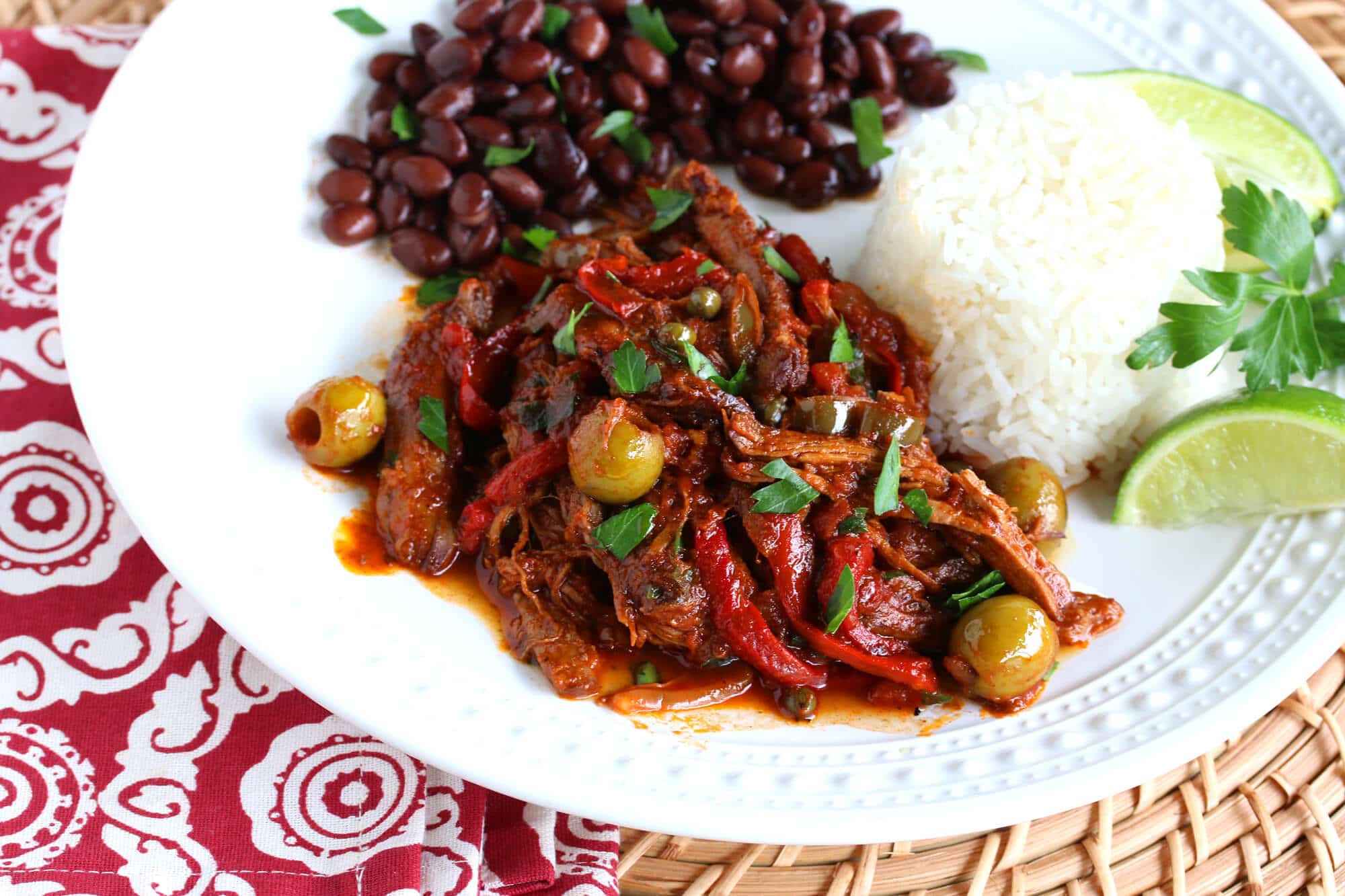
Ropa Vieja Recipe
Let’s get started!
Pat the beef dry and sprinkle with salt and freshly ground black pepper. Heat the oil in a Dutch oven over high heat. Once very hot add the beef and brown generously on all sides. I’m using my Le Creuset Dutch oven. I also have the Lodge Dutch oven that is a fraction of the price and I love them both.
Transfer the beef to a plate. Do not discard the drippings and blackened bits in the pot, they are key to the flavor.
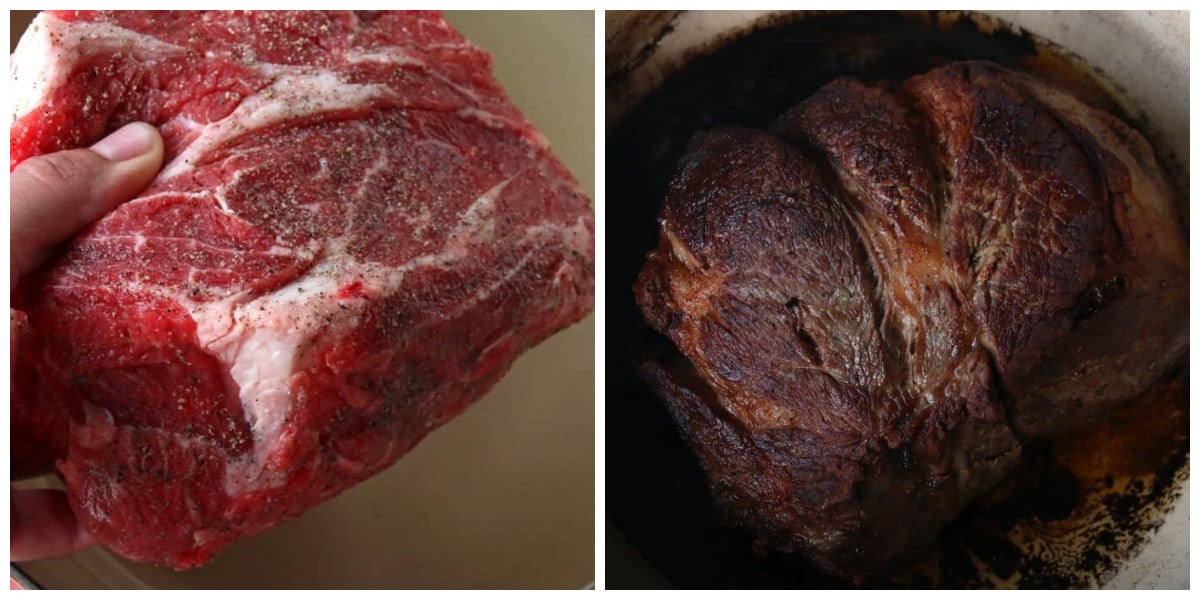
Add the sliced vegetables to the pot and cook over medium heat for 15-20 minutes until caramelized.
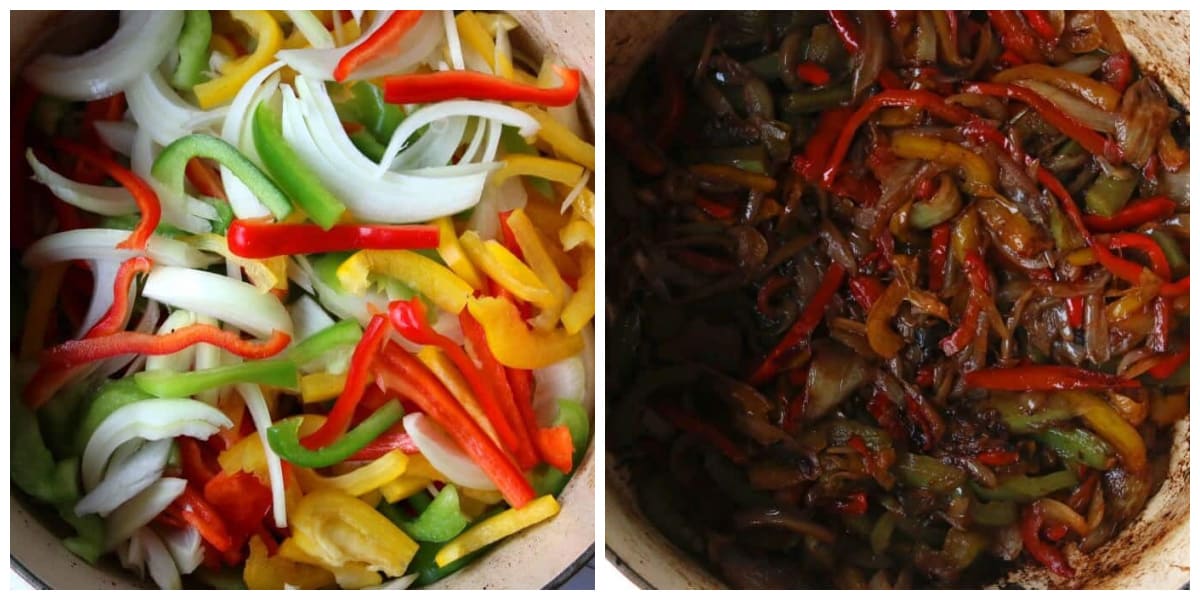
Add the garlic and spices and cook for another minute.
Add the white wine and bring it to a rapid boil, deglazing the bottom of the pan (scraping up the browned bits on the bottom of the pan).
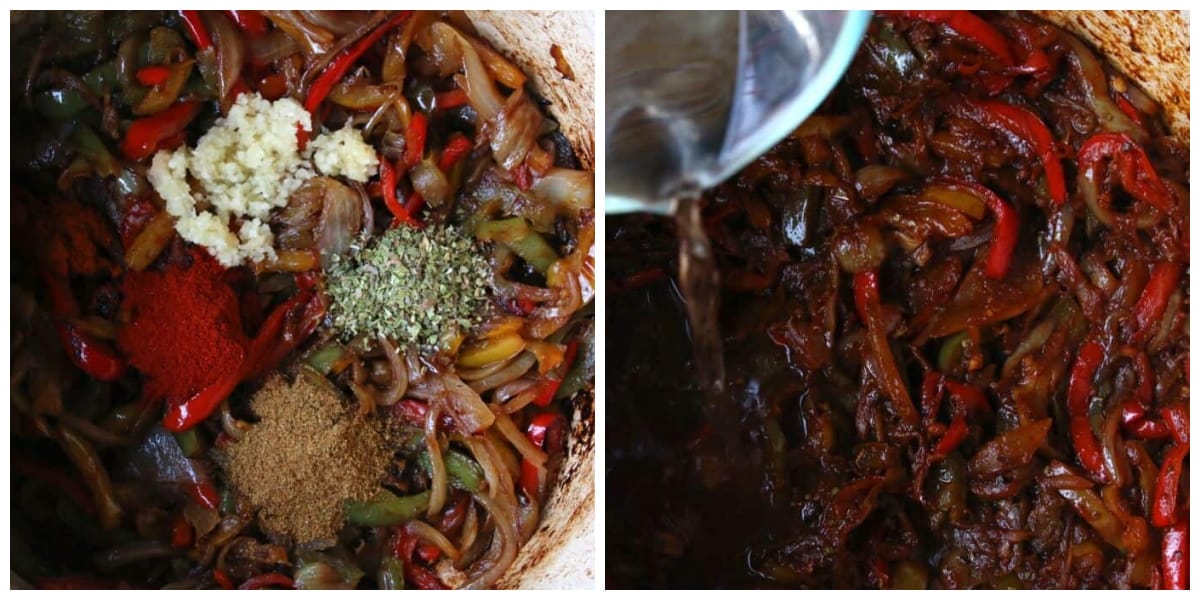
Add the broth, crushed tomatoes, tomato paste and bay leaves. Simmer for 5 minutes.
Return the roast to the pot along with the pieces of carrots and celery. Bring to a boil, reduce the heat to low, cover and simmer for 3-4 hours or until the beef is fork tender and falls apart easily.
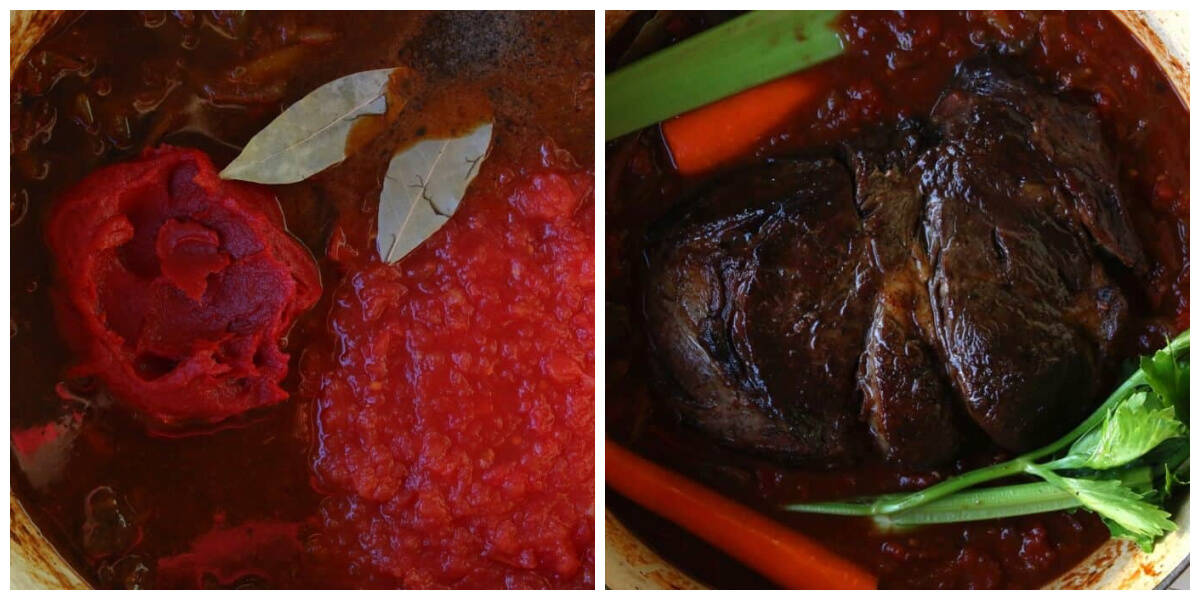
Discard the celery, carrots and bay leaves.
Transfer the beef to a plate and shred it with two forks.
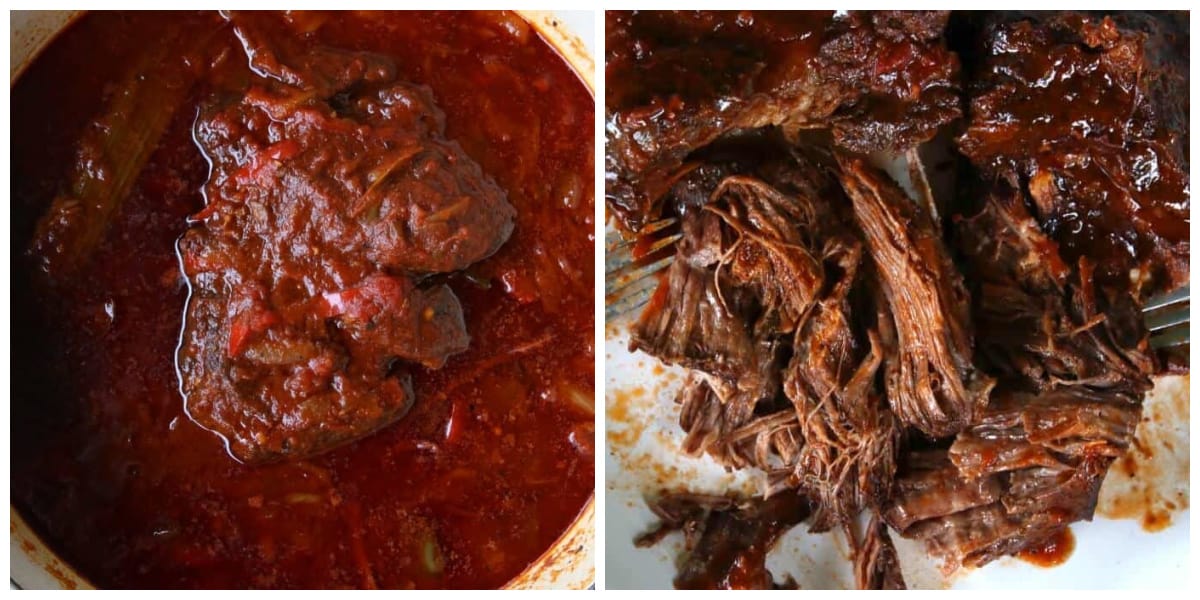
Return the shredded beef to the sauce. Stir in the olives, roasted red peppers, capers and pimientos. Simmer uncovered to thicken the sauce for 30 minutes.
Stir in the parsley. Add salt and pepper to taste.
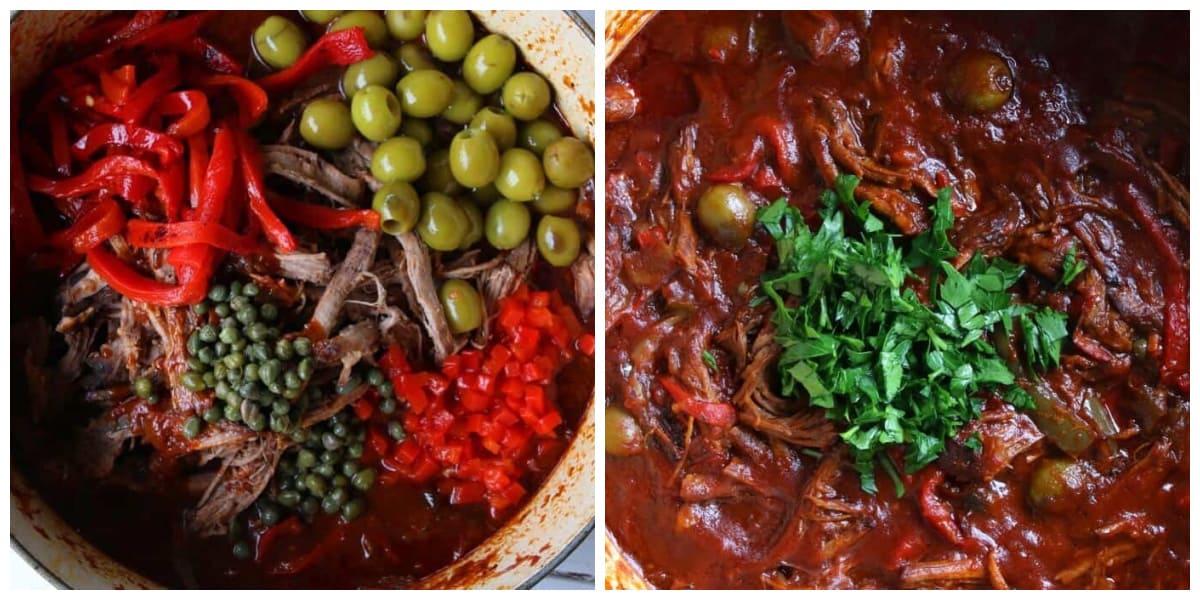
Your Ropa Vieja is ready to serve.
And its flavor only improves the next day if you can be patient enough to wait!
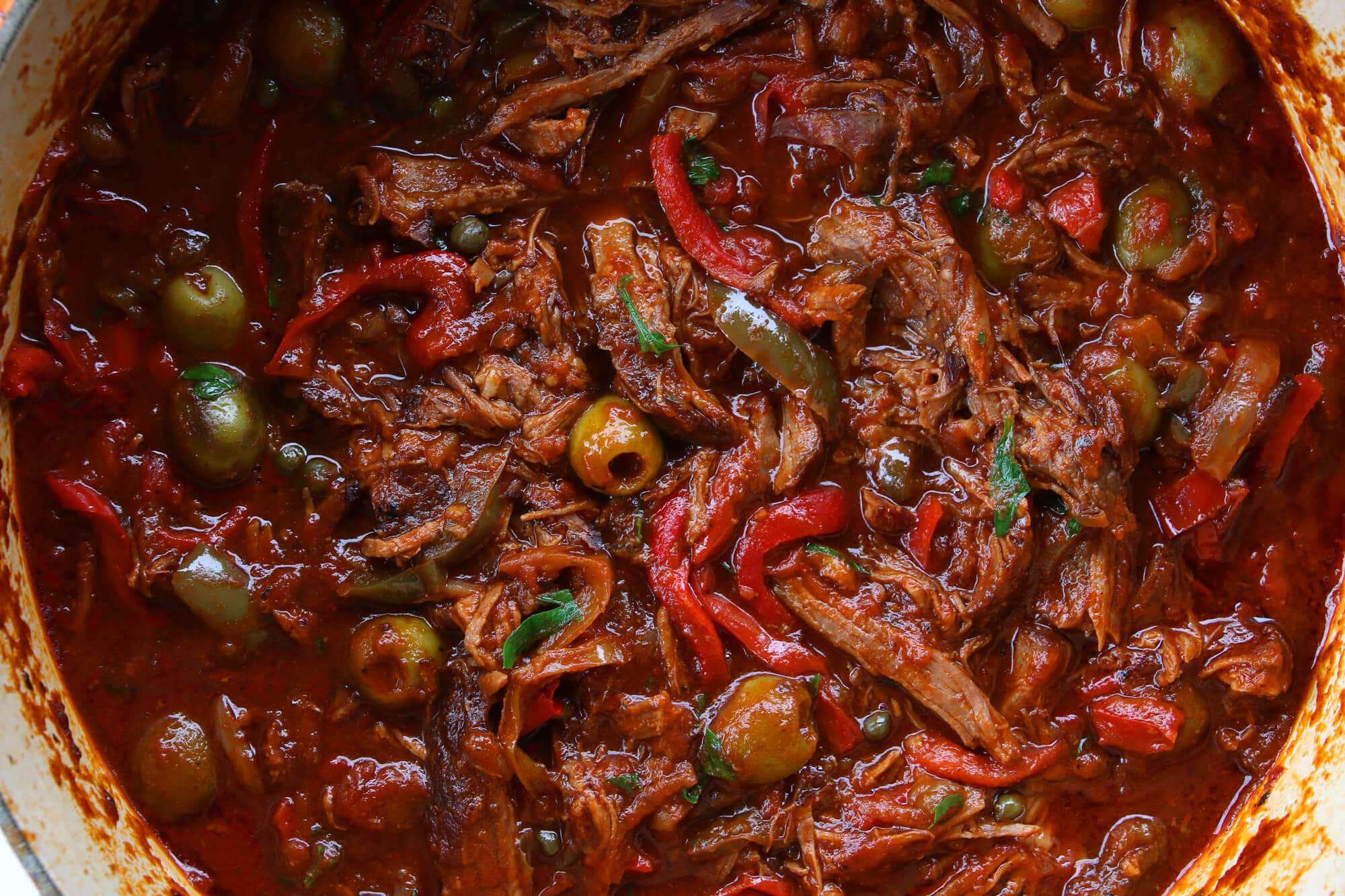
Serve with steamed or yellow rice and black beans. And for an additional treat, include some crispy homemade Tostones!
Ropa Vieja only tastes better the next day as the flavors have more time to meld, so this is a perfect dish to make in large batches for leftovers!
Enjoy!
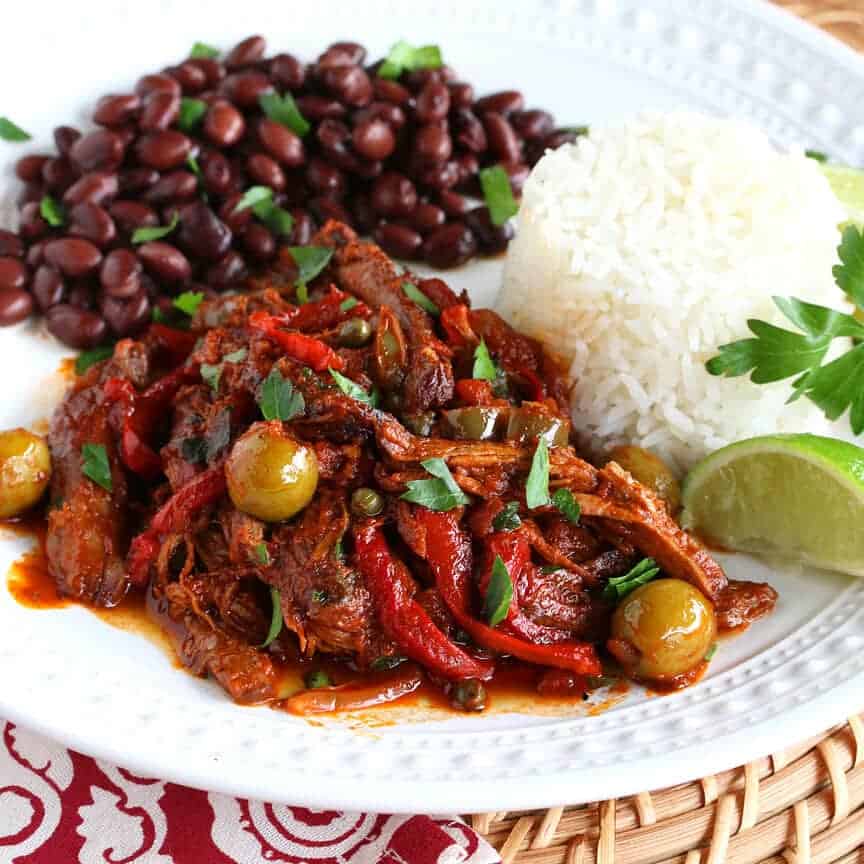
For more incredible beef stews from around the world be sure to try my:
- Guinness Stew
- Hungarian Goulash
- Sega Wat (Spicy Ethiopian Beef Stew)
- Pörkölt (Hungarian Beef and Onion Stew)
- German Goulash
- BEST Beef Stew
- Pichelsteiner
- Beef Bourguignon
- Hachee (Dutch Beef and Onion Stew)
- Domoda (Gambian Peanut Stew)
Save This Recipe
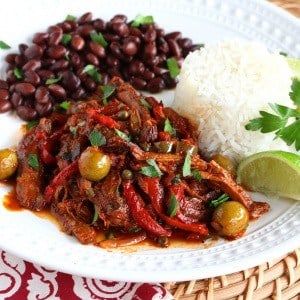
Ultimate Ropa Vieja
Ingredients
- 2 pounds chuck ask your butcher to cut it taller than wider so you get long strands of beef along the grain. OR you can use flank steak (see discussion in this post about cuts of beef and why we recommend chuck over flank)
- 1 large yellow onion thinly sliced
- 1 of each large green red and yellow bell pepper, thinly sliced
- 4 cloves garlic minced
- 2 teaspoons dried oregano
- 2 teaspoons ground cumin
- 2 teaspoons sweet paprika
- 1 teaspoon smoked paprika
- 1/8 teaspoon ground allspice
- 1/8 teaspoon ground cloves
- 2 teaspoons kosher salt
- 1/2 teaspoon freshly ground black pepper
- 1/2 cup dry white wine
- 1 cup chicken broth
- 16 ounce can crushed tomatoes
- 6 ounce can tomato paste
- 2 bay leaves
- 1 large carrot cut in half
- 1 large stalk celery cut in half
- 1 cup green olives , rinsed and drained (you can slice them if you prefer)
- 1/2 cup roasted red peppers , drained
- 1/4 cup pimientos , drained
- 2 tablespoons capers , rinsed and drained
- 1/3 cup chopped fresh parsley
Instructions
- Pat the beef dry and sprinkle with salt and freshly ground black pepper.Heat a little oil in a Dutch oven over high heat. Once very hot add the beef and brown generously on all sides. Transfer the beef to a plate. (Do not discard the drippings and blackened bits in the pot, they are key to the flavor.)Add the sliced vegetables to the pot and cook over medium heat for 15-20 minutes until caramelized. Add the garlic and spices and cook for another minute. Add the white wine and bring it to a rapid boil, deglazing the bottom of the pan (scraping up the browned bits on the bottom of the pan).Add the broth, crushed tomatoes, tomato paste and bay leaves. Simmer for 5 minutes.
- Return the roast to the pot along with the pieces of carrots and celery. Bring to a boil, reduce the heat to low, cover and simmer for 3-4 hours or until the beef is fork tender and falls apart easily. Discard the celery, carrots and bay leaves.
- Transfer the beef to a plate and shred it. Return the shredded beef to the pot.Stir in the olives, roasted red peppers, capers and pimientos. Simmer uncovered to thicken the sauce for 30 minutes. Stir in the parsley and add salt and pepper to taste.
Notes
Nutrition
Originally published on The Daring Gourmet June 27, 2016



















Hi…can this be made in a slow cooker?
How would you modify the cooking if you made this dish with chicken?
Hi Melinda, I would use skin-on, bone-in chicken pieces for maximum flavor. I would brown the pieces (again, for flavor) and then slow simmer them until they’re done, then take them out, discard the skin, remove the meat from the bones, shred it, and return it to the pot.
The flank steak actually work very well in this recipe since it simmers for such a long time in the sauce. Just saying.
Hi Sarah, it works but it’s not the ideal choice. It’s been the traditional cut for this dish because of its historically low cost (though not anymore!) and it’s shape (long strands), not because of its quality, texture or flavor. As I discuss in my post, because of its low fat content, flank steak is best suited to very quick, high heat cooking, like grilling. It’s not the best choice for braising or slow cooking because without the fat content and connective tissue it dries out during the cooking process. Lacking fat, it’s also not the most flavorful cut of beef. But if it’s what you have on hand, yes you can definitely use it.
Can I put in the oven instead of using Stovetop? Agree with previous comment, but gas stove is hard to control with the right low temp.
Hi Susana, absolutely. I’d heat the oven to 300 F and aim to cook it for around 2 1/2 hours (depending on the cut of meat) or until the meat is fork tender.
This is the best Ropa Vieja recipe! I’ve made it numerous times and it’s always a hit with my family and friends
That’s fantastic, Misha, thank you so much! :)
This is sooo delicious! I cannot get chuck here (we live in Luxembourg where they cut meat differently) so I tried it with shoulder and high rib, both good. Other than that I kept to the recipe. It’s a bit of prep work but totally worth it!!
I’m so glad you enjoyed it, Monika, thank you very much! :)
I am so excited to make this today! My problem is that I can’t find sweet paprika anywhere in my town. Can you recommend a substitute?
Hi! Unless it’s specifically labeled “hot paprika” it is sweet paprika. In other words, if it’s labeled simply “paprika”, that’s what you need!
Spanish paprika works
This recipe came out absolutely phenomenal. I made it with fire roasted tomatoes and it added a nice smokiness to it. I also added just a teaspoon of sugar at the end to balance all the saltiness. Served it with Madurai, brown rice, and Cuban black beans. My husband thought it was better than the local Cuban restaurant that makes it!
Thank you so much, Sailor, I’m so glad you both enjoyed it!
Cuban-approved! This came out great, thank you! (flank)
Love the recipe but when I use chuck roast instead of the flank steak my grandmother says that it is called carne Machada not ropa vieja same recipe using chuck steak but they’re both great I prefer the carne machada because of the flavor the chuck roast imparts into the sauce. Tomato/Tomato.
I’ve made this a 8 times using this recipe and its always amazing. This is the first time I used a 6 lb cut of chuck (I’ve always used flank previously) from the butcher to get those long strands of beef. Wow! I will never go back to flank. The rendering of the fat makes an incredible flavor.
Also I make dozens of Ropa vieja empanadas with the leftovers. Freeze them and reheat anytime for an awesome quick meal.
Thanks for sharing this recipe it’s been a blessing!
Allen
Awesome, thanks so much for the feedback, Allen! I’m glad you’re happy with the chuck and I completely agree about the fat. Using this for empanadas sounds FANTASTIC!
I’d tried a number of different recipes for ropa vieja over the years until I came across yours. That settled it – no more looking. I’ve made this repeatedly over the past five or six years and it’s always a hit. I’m an American living in Germany, so Caribbean spices aren’t normal fare, yet my French partner, her family and friends from Martinique and Cuba give full thumbs up every time it’s on the table. Tomorrow, I’ll live dangerously – gonna try the slow cooker.
I couldn’t ask for a better compliment or vote of approval, Larry, thank you so much!
I grew up in Miami and my ex is Cuban. This is the best Ropa Vieja I have ever had! I agree the chuck is much better than dry flank steak.
How did it work in the slow cooker?
Try it with flank. Don’t care what butchers say. I go for tradition, and those long, rag-like fibers are a key part of the dish. My picky wife and kids love Ropa vieja and the one time I could not find flank steak, they definitely noticed the difference.
Agree 100%. In my kitchen we use flank steak for ropa vieja. Yes, it is affordable which is why the recipe is so perfect. Delicious food made from what is available passed down over decades. The marinade and slow cook breaks it down perfectly.
Delicious! I made this with flank steak, but my cooktop is super fast (can’t get the gas low enough), so after adding the meat back in I put it in the oven for 2 hours at 325 F–bubbling. When I added the olives etc I and finished it on thecooktop. I served this with Cuban black beans and brown rice (pretending we are healthy)–and red wine! Loved it!
Awesome, Kris, thank you so much for the feedback!
I lived overseas and had the same problem with the stove. Someone showed me, if you lift the top of the stove up (in my case), there is a very small “knob” for each burner to set the gas flame height/intensity. Sometimes it is near each burner. Hope that helps you as most recipes call for simmering.
This was phenomenal! I made it exactly as written & I can’t understand anyone giving it less than 5 stars. It’s different than any ropa vieja I’ve ever had at any restaurant but it’s better. I put the capers, olives, pimentos & roasted red peppers in cheese cloth so I could benefit from the flavor but not have to eat them. I would suggest others do the same with any of the ingredients they don’t usually care for. Just don’t skip them! Trust me!
So awesome, Jennifer! I’m thrilled you enjoyed it, thanks so much for the feedback!
Great idea. My family does not like olives, capers and pimientos, only me. I will add the all to my plate at the end. =)